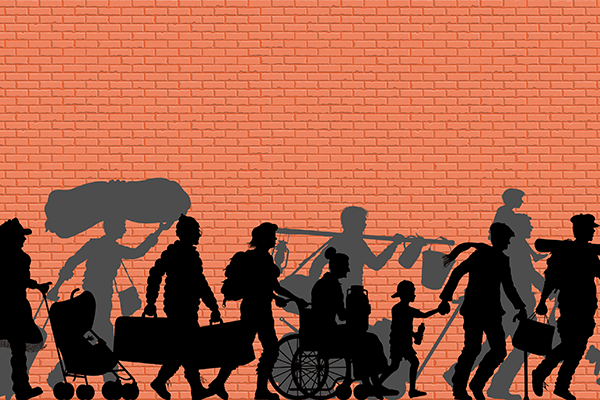IT SHOULD HAVE surprised no one when Donald Trump, who boasted to a New York City crowd, “On day one, I will launch the largest deportation program in American history to get the criminals out,” began carrying out his promise on Inauguration Day. Immigrants have been the target of Trump’s most aggressive rhetoric since he entered politics a decade ago, and he loves hyperbole. Trump is making the removal of migrants a centerpiece of his new administration by declaring a state of emergency on the U.S.-Mexico border, mobilizing National Guard units, and sending troops to do his bidding. The warlike imagery and language he uses are hard to hold alongside the Christian belief that we are all created in God’s image.
With approximately 11 million undocumented residents in the United States, there is legitimate reason to fear what Trump is enacting in his second administration. I say this as someone who witnessed what a Trump-appointed federal prosecutor called “the largest single-state immigrant enforcement operation in our nation’s history” during Trump’s previous administration. It occurred in 2019, in Mississippi, where I live. I know that whatever else happened that day, children were left without parents, families were cut off from loved ones, and communities were filled with a sense of confusion and terror. But I also know from that experience that, even in the worst moments, there were people and places where hope and comfort resided, too.
On day one, Trump began translating his campaign rhetoric to actual deportation methods. The point is sometimes made that Trump’s first administration deported fewer people than Biden’s or either of Obama’s administrations. While that may be accurate, context is everything. For example, deporting someone who just crossed the border illegally is very different from deporting someone who has lived in the U.S. for 20 years. While the numbers of people matter for each impacted individual and family, it also matters how people are targeted and why inciting terror is the tool of choice. Tom Homan, who Trump has chosen to oversee the nation’s borders, has said we should expect “shock and awe” from the current administration’s deportation efforts. That comment, coupled with Homan’s promise to conduct more workplace raids, suggests how deportations will be handled. That language calls to mind the workplace raids that U.S. Immigration and Customs Enforcement (ICE) officials conducted in Mississippi in 2019.
One day in August of that year, roughly 650 federal agents entered seven chicken processing plants in rural Mississippi, taking about 680 employees into custody. Most, if not all, were immigrants. One was a man named Raul Castellanos-Posadas. Raul’s brother is a friend of mine. I was there when he received a frantic phone call about Raul being apprehended. Later, when he learned Raul was detained 150 miles away at the Richwood Correctional Center in Louisiana, he wanted to put money on his brother’s commissary account but was scared to travel to the prison, afraid that he, too, would be detained. I went in his place several times. (And I was told by security personnel that some undocumented visitors had, in fact, been detained when they came to visit family and friends.) Each time, with the help of a translator, Raul told me his story.
He was a 41-year-old bachelor, originally from Veracruz, Mexico, who migrated to Mississippi in 2003. His goal was to work long enough to save the money to return home and purchase some land. To that end, he took a chicken plant job in the town of Morton (population 3,400) making $8 an hour. Sixteen years later, on the morning ICE rounded him up at gunpoint, Raul had the same position. He now was earning $14.05 an hour. He had no criminal record.
Whether intentional or not, the date the ICE agents chose to execute the warrants was the first day of school for more than 1,000 children whose families were affected by the raids. “They learned at the end of the school day that there may not be anybody at home waiting for them,” said Cliff Johnson, director of the MacArthur Justice Center at the University of Mississippi, in an interview with NPR.
Raul had no children, but when confronted by armed men in the plant that day, he thought of something far worse. Four days earlier, a 21-year-old white man had killed 23 Latinos at a Walmart in El Paso, Texas. Only when the agents at the plant began asking questions about citizenship status did Raul realize they were not assassins. He figured he would get into more trouble if he lied to ICE, so he answered their questions truthfully. Then he was placed in shackles and later transported to the Louisiana prison where I visited him. He eventually signed documents agreeing to be deported back to Mexico. He did this, I am told, because he believed it would help his chances of being admitted back to the country legally one day.
As disheartening as it was, there were moments of grace throughout Raul’s story — examples of people who stepped into the gaps to help. That initial phone call Raul’s brother received about the raid? It came from a local restaurant owner who was also an immigrant, in the country legally, and who essentially turned her business into a safe house for migrants and helped relay information for them. Raul’s brother sought counsel from the Mississippi Immigration Coalition, an ad hoc group of volunteer lawyers and social workers who formed in the immediate aftermath of the Mississippi raids. They ultimately could not help but their efforts left my friend and Raul with a much-needed sense of support. And the location where that help was offered? A local Catholic church opened its doors to families impacted by the raids. These small moments parallel several of the tips that the National Immigrant Justice Center suggests to those at risk, including having a communication plan in place and seeking legal advice.
While I worry about what is transpiring under Trump’s second administration, I also recall those moments of grace and creative responses.

Got something to say about what you're reading? We value your feedback!







